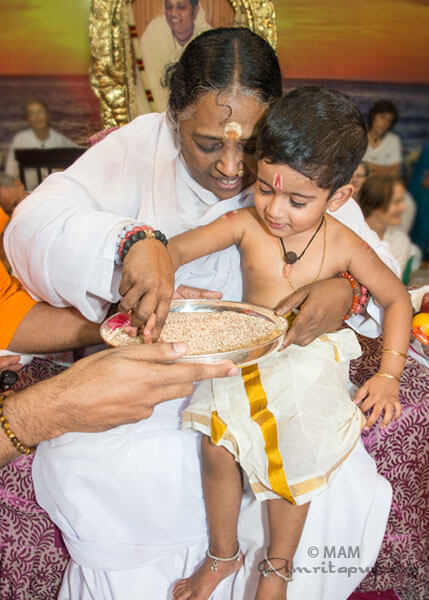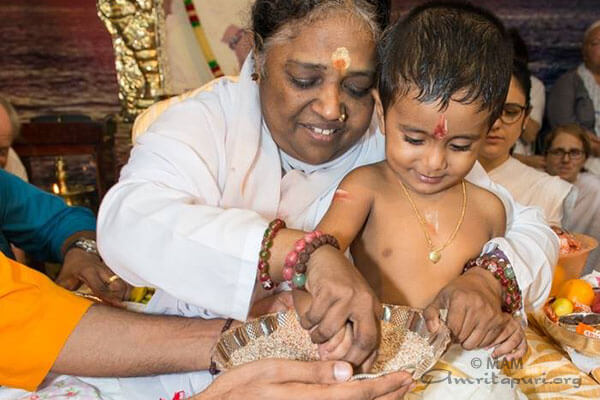Children, Navaratri is an occasion for worshiping Parashakti, the Almighty Goddess, who is the cause of the universe.
Navaratri is a time for vows, austerities and worship. The ways of worshiping vary from place to place. In some places, a different aspect of Devi is worshiped on each day. In other places, She is worshiped as Kali or Durga during the first three days, as Lakshmi in the next three days, and as Saraswati in the last three days. In yet other places, the worship is performed only during the last three days.

Negativities such as excessive sleepiness, sloth, lust, anger, pride, envy, impatience and a lack of faith are obstacles to doing spiritual practices and making spiritual progress. Conquering them through penance and thus attaining spiritual fulfillment—this is the principle that Navaratri conveys. Not only that, through prayer, one also gains power, auspiciousness and knowledge. Through vows, we can increase our will power and gain greater self-control. Vijayadasami marks the successful completion of this occasion.
On the day of Durga-ashtami, we offer our books and the tools of our trade for puja (worship) as an expression of gratitude for the blessings received in the previous year.
A tailor keeps his needle for puja, and a warrior, his gun. Likewise, a doctor or a butcher might keep the tools of his trade for worship. This is because people depend on them to earn their living. By offering the tools to God, one commits to performing all work as worship.
Thereafter, we receive them as Prasad, and begin life afresh. Vijayadasami is an auspicious occasion for any new noble undertaking. We initiate children into learning that day by making them write the syllables “Harishree…”. The mantra, “ ॐ हरिः श्री गणपतये नमः / Om Hari Shree Ganapataye Namah,” represents the whole universe of letters. Human beings gain knowledge mainly through the alphabet. When Devi, who is the embodiment of language, shines forth in the mind and on the tongue, the mute becomes eloquent, and the illiterate, scholarly.
The ultimate truth is Pure Consciousness. It undergoes no change when the universe manifests from It. We refer to the power behind it as Devi. God and divine power are not two; they are one and the same, just as sun and its light, honey and its sweetness, a word and its meaning.
We have the freedom to worship God in any form we like. We can worship Him as Mother, Father, Guru, Friend, the Lord or as our own child. The only thing is, our worship should be based on spiritual principles. Among human relationships, the one between mother and child is highest. The child has total freedom with his mother. He gets what he wants by crying or through willfulness. Even if the mother spanks her child, he will hold on to her tightly. “I have no other refuge than the mother”—this is his attitude. No matter what the cause of his distress, he finds consolation in his mother’s lap. This is the attitude we should have towards God. The mother is the embodiment of patience. No matter how many times the child errs, the mother forgives him repeatedly and showers her affection on him. However, most mothers have such love only for their own children, whereas the Divine Mother’s attitude combines both love towards all beings in the universe and spiritual discipline.
Some ask ‘why we refer to Devi as Maya. Doesn’t Maya lead us to delusion, sorrow and bondage? Why then do we worship Devi’? The universe is the visible manifestation of Devi. She pervades all forms. As She is everything, Maya, too, is Devi. Devi is the one who liberates both Maya and the Mayavi (magician) from delusion. Devi is knowledge and ignorance. Knowledge leads one to Truth. Ignorance leads one to untruth and sorrow. Because Devi is everything, She is both knowledge and ignorance, as well as the supreme truth, which is the substratum of both. Maya is nothing other than our own mind. It is not some outer force. Maya is the root form of the mind. The mind is the cause of bondage and liberation.

Once, a band of thieves robbed a person of his valuables, bound him with rope, and pushed him inside a well. The victim shouted for help. Hearing his calls, a few people went to the well. Seeing him, they threw a rope inside the well and saved him. A rope bound him. Later, another rope saved him. Similarly, the mind alone is the cause of both bondage and liberation. We can lock the door when we turn the key towards left; unlock the door when we turn towards the right. But the key remains the same. How we use it determines whether we unlock the door or not. Similarly, the mind alone is the cause of both bondage and liberation. Most of our sorrows are caused by misconceptions. At dusk, the sun sets into the sea. A child cries, imagining the sun is drowning. Such is the case with most of our sorrows.
God has assigned everything its own place in the universe. There is no great or small. See and revere everyone as God. We need this equal vision. This is also the message behind the bommakkolu (multi-tiered arrangement of idols) associated with Navaratri. We worship even the most insignificant idol in the bommakkolu as a part of Devi. Supreme devotion is seeing, loving, serving and worshiping everything as the Universal Mother.
We need to awaken the right knowledge from within. We need to gain scriptural knowledge and practice those teachings in our life. May Navaratri awaken this attitude in all my children. May divine grace bless you all.
-Excerpts from Amma’s Navaratri message, Amritapuri, 11 Oct 2016
